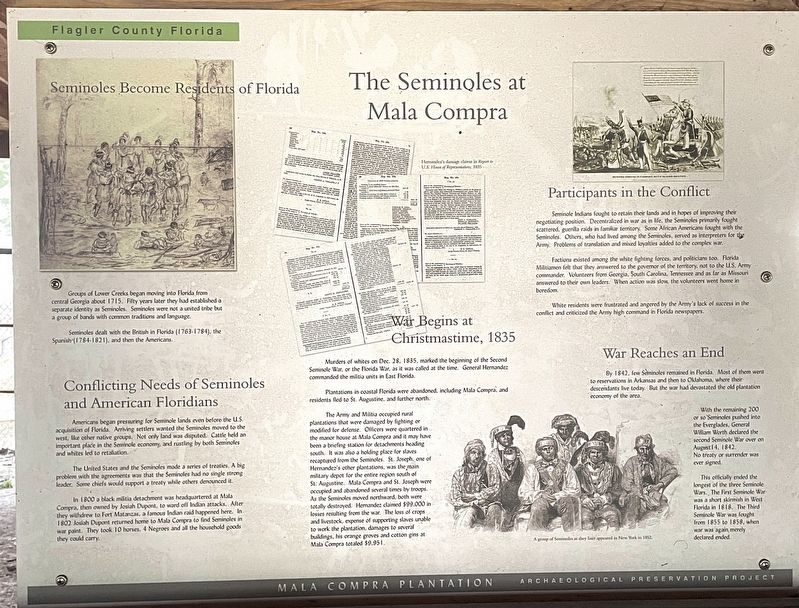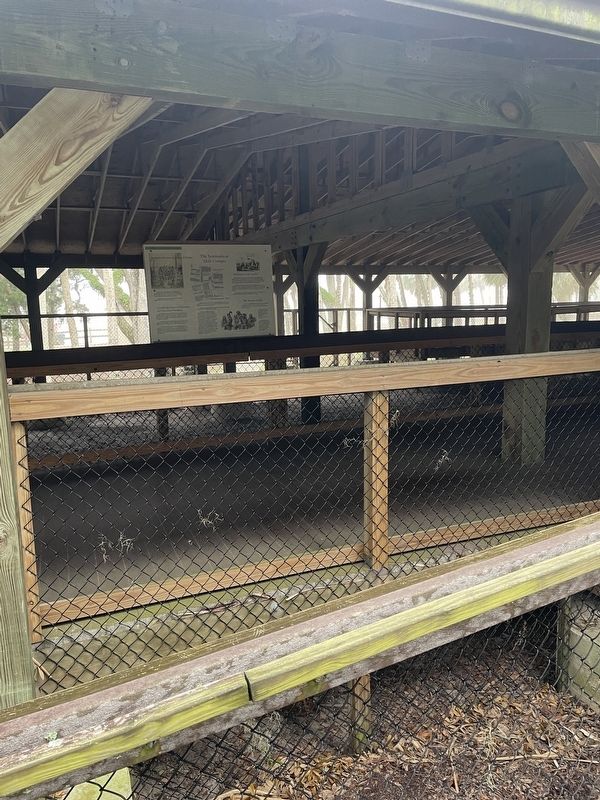Palm Coast in Flagler County, Florida — The American South (South Atlantic)
The Seminoles at Mala Compra
Mala Compra Plantation Archaeological Site
Seminoles Become Residents of Florida
Groups of lower Creeks began moving into Florida from central Georgia about 1715. Fifty years later they had established a separate identity as Seminoles. Seminoles were not a united tribe but a group of bands with common traditions and language.
Seminoles dealt with the British in Florida (1763-1784), the Spanish (1784-1821), and then the Americans.
Conflicting Needs of Seminoles and American Floridians
Americans began pressuring for Seminole lands even before the U.S. acquisition of Florida. Arriving settlers wanted the Seminoles moved to the west, like other native groups. Not only land was disputed. Cattle held an important place in the Seminole economy, and rustling by both Seminoles and whites led to retaliation.
The United States and the Seminoles made a series of treaties. A big problem with the agreements was that the Semínoles had no single strong leader. Some chiefs would support a treaty while others denounced it.
In 1800 a black militia detachment was headquartered at Mala Compra, then owned by Josiah Dupont, to ward off Indian attacks. After they withdrew to Fort Matanzas, a famous Indian raid happened here. In 1802 Josiah Dupont returned home to Mala Compra to find Seminoles in war paint. They took 10 horses, 4 Negroes and all the household goods they could carry.
War Begins at Christmastime, 1835
Murders of whites on Dec. 28, 1835, marked the beginning of the Second Seminole War, or the Florida War, as it was called at the time. General Hernandez commanded the militia units in East Florida.
Plantations in coastal Florida were abandoned, including Mala Compra, and residents fled to St. Augustine, and further north.
The Army and Militia occupied rural plantations that were damaged by fighting or modified for defense. Officers were quartered in the manor house at Mala Compra and it may have been a briefing station for detachments heading south. It was also a holding place for slaves recaptured from the Seminoles. St. Joseph, one of Hernandez’s other plantations, was the main military depot for the entire region south of St. Augustine. Mala Compra and St. Joseph were occupied and abandoned several times by troops. As the Seminoles moved northward, both were totally destroyed. Hernandez claimed $99,000 in losses resulting from the war. The loss of crops and livestock, expense of supporting slaves unable to work the plantation, damages to several buildings, his orange groves and cotton gins at Mala Compra totaled $9,951.
Participants in the Conflict
Seminole Indians fought to retain their lands and in hopes of improving their negotiating position. Decentralized in war as in life, the Seminoles primarily fought scattered, guerrilla raids in familiar territory. Some African Americans fought with the Seminoles. Others, who had lived among the Seminoles, served as interpreters for the Army. Problems of translation and mixed loyalties added to the complex war.
Factions existed among the white fighting forces, and politicians too. Florida Militiamen felt that they answered to the governor of the territory, not to the U.S. Army commander. Volunteers from Georgia, South Carolina, Tennessee and as far as Missouri answered to their own leaders. When action was slow, the volunteers went home in boredom.
White residents were frustrated and angered by the Army’s lack of success in the conflict and criticized the Army high command in Florida newspapers.
War Reaches an End
By 1842, few Seminoles remained in Florida. Most of them went to reservations in Arkansas and then to Oklahoma, where their descendants live today. But the war had devastated the old plantation economy of the area.
With the remaining 200 or so Seminoles pushed into the Everglades, General William Worth declared the second Seminole War over on August 14, 1842. No treaty or surrender was ever signed.
This officially ended the longest of the three Seminole Wars. The First Seminole War was a short skirmish in West Florida in 1818. The Third Seminole War was fought from 1855 to 1858, when war was again merely declared ended.
(captions)
Hernandez’s damage claims in Report to U.S. House of Representatives, 1835
A group of Seminoles as they later appeared in New York in 1852.
Erected by 2020 by Flagler County Board of Commissioners, Florida Department of State Division of Historical Resources and Visions 2020 Historical Task Force.
Topics. This historical marker is listed in these topic lists: African Americans • Native Americans • Settlements & Settlers • Wars, US Indian. A significant historical year for this entry is 1715.
Location. 29° 36.946′ N, 81° 12.219′ W. Marker is in Palm Coast, Florida, in Flagler County. Marker can be reached from North Ocean Shore Boulevard (Florida Route A1A) 0.1 miles north of Mala Compra Drive, on the left when traveling north. Located within Mala Compra Plantation Archaeological Preservation Site. Touch for map. Marker is at or near this postal address: 5873 N Ocean Shore Blvd, Palm Coast FL 32137, United States of America. Touch for directions.
Other nearby markers. At least 8 other markers are within one mile of this marker, measured as the crow flies. A Plantation in early Florida (within shouting distance of this marker); Joseph Hernandez (within shouting distance of this marker); Mala Compra Plantation Historic Site (within shouting distance of this marker); The Old Coast Guard Road (approx. 0.8 miles away); What does Mala Compra Mean? (approx. 0.8 miles away); Coquina Columns (approx. 1.1 miles away); Washington Oaks Gardens (approx. 1.1 miles away); Young Home (approx. 1.1 miles away). Touch for a list and map of all markers in Palm Coast.
Also see . . . A Plantation in early Florida. (Submitted on November 5, 2022, by Brandon D Cross of Flagler Beach, Florida.)
Credits. This page was last revised on November 7, 2022. It was originally submitted on November 5, 2022, by Brandon D Cross of Flagler Beach, Florida. This page has been viewed 135 times since then and 25 times this year. Photos: 1, 2. submitted on November 5, 2022, by Brandon D Cross of Flagler Beach, Florida. • Bernard Fisher was the editor who published this page.

